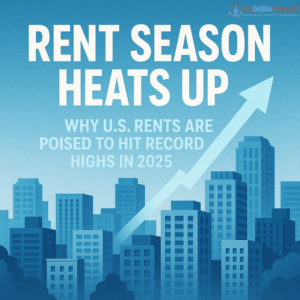As the temperatures rise, so do the rents. According to a recent Business Insider article, the U.S. rental market is entering a new chapter—one marked by renewed price surges, consumer anxiety over inflation, and regionally diverging trends. With the economy sending mixed signals and mortgage rates remaining elevated, renters are once again finding themselves at the mercy of a competitive and costly market.
1. Rents Rising Again—and Fast
Data from Zumper shows rents climbing steadily across the country. In March 2025:
-
One-bedroom units hit a national median of $1,524, just shy of the previous month’s all-time high of $1,525.
-
Two-bedrooms reached $1,905, a jump that highlights consistent demand.
The year-over-year increases—2.5% for one-bedroom and 3.1% for two-bedroom rentals—signal more than seasonal change. They reflect deep structural issues in housing supply, increased inflation expectations, and a hesitancy among would-be homebuyers priced out by mortgage rates.
2. Inflation Fears Are Shaping Renter Behavior
The latest data from the Conference Board shows U.S. consumers now expect inflation to rise 6.2% over the next 12 months, up from 5.8% just a month earlier. This growing anxiety isn’t just theoretical—it’s influencing real behavior.
Many renters are opting to sign leases early or lock in rates out of fear that delaying could lead to much higher monthly costs. This early-season rush is creating upward pressure on rents before summer even begins.
3. Urban Hotspots Are Surging Again
Not all cities are experiencing the same rent dynamics. The major urban centers—once flattened by pandemic-era migration—are bouncing back stronger than ever.
-
San Francisco saw a staggering 10.3% year-over-year rent increase, with the median reaching $3,200—its highest in five years.
-
New York City rents surged 6.4% year-over-year, just $30 shy of their record peak.
-
Across 100 tracked cities, 59 saw monthly rent increases, and 17 reported double-digit annual growth.
These numbers show that the “urban exodus” of 2020-2021 has clearly reversed, bringing demand—and price hikes—back to coastal powerhouses.
4. A Tale of Two Markets: Oversupply vs. Scarcity
Interestingly, not all metros are feeling the squeeze equally. Some areas in the Sun Belt—including parts of North Carolina and Texas—are seeing rents decline due to a rare phenomenon: oversupply.
In these regions, builders flooded the market in response to previous demand spikes. Inventory reached 50-year highs, temporarily softening prices. But this is the exception, not the rule. In most of the U.S., low inventory, high borrowing costs, and continued population growth are combining to sustain upward rent pressure.
5. Rents Are Driving Broader Inflation
There’s a deeper issue here: rents are not just a cost for tenants—they’re a core driver of inflation. The shelter component of the Consumer Price Index (CPI) has been sticky, largely because rent increases take time to cycle through lease renewals and new contracts.
While CPI shelter inflation showed a year-over-year increase of 4% in April, platforms like Zumper suggest real-time rent growth is running even hotter. As a result, policy makers are struggling to tamp down inflation even as wage growth cools and consumer spending softens.
6. Is a Recession the Only Thing That Can Cool the Market?
Zumper CEO Anthemos Georgiades puts it bluntly: “It feels like the calm before the storm.” And many analysts agree. If current trends persist, new record-high rents are all but inevitable by mid-2025.
But there’s one potential wrench: a recession. Should the economy tip into a significant downturn, we could see weakened demand, stalled lease renewals, and a modest dip in rent prices. However, current outlooks suggest weak economic growth—not a full-scale recession—keeping demand steady enough to continue pushing rents upward.
What This Means for Renters and Investors
If you’re a renter:
-
Act early. Locking in your lease now could save you hundreds in the coming year.
-
Explore markets with more supply. Sun Belt regions may offer temporary affordability relief.
-
Watch the inflation data. It will be a major indicator of where rents head next.
If you’re a real estate investor:
-
High rents mean high returns—but tread carefully. Recession risk and affordability backlash could create new regulations or soften the market in 2026.
-
Stay informed on local trends. Rent growth is not uniform—know your submarket.
Final Thoughts
The rental market in 2025 is being shaped by a potent mix of inflation expectations, consumer behavior, tight supply, and economic uncertainty. For many Americans, the cost of shelter is becoming a growing burden—one that won’t ease without serious investment in housing stock or a sharp change in the economic outlook.
As peak rental season begins, all signs point to this year becoming another record-breaker for rents—unless a broader economic slowdown throws a wrench in the momentum.
Source:Business Insider – Rent is destined to reach record highs as the weather and inflation expectations heat up

